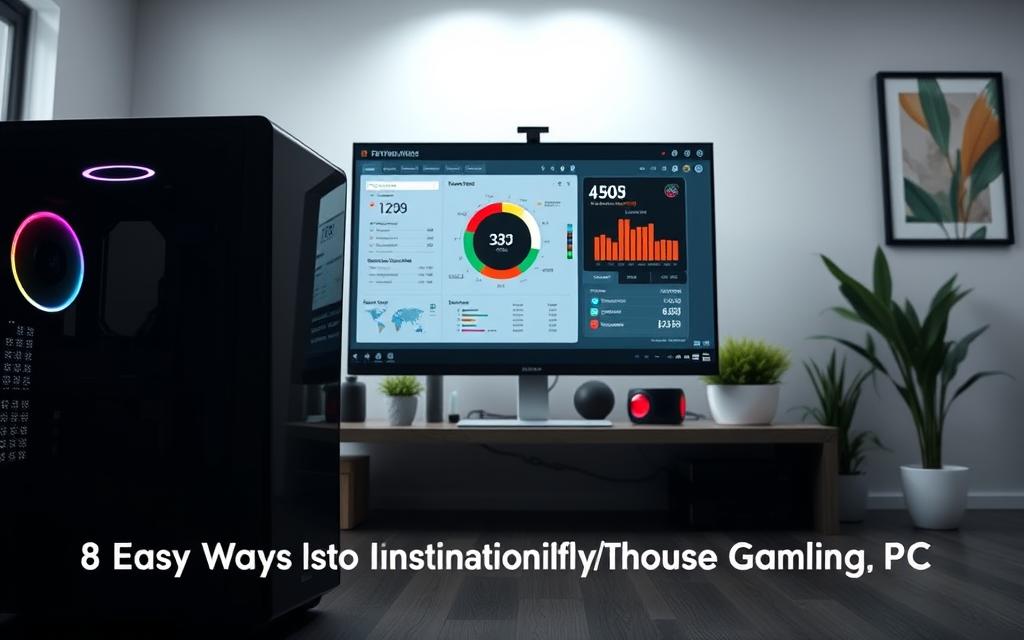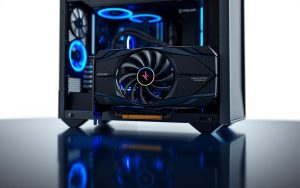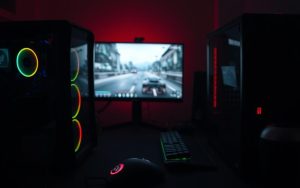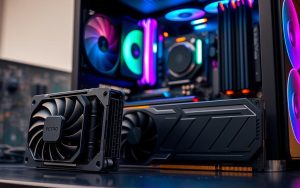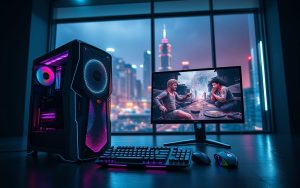Table of Contents
Want a smoother experience in demanding games like Baldur’s Gate 3 or Cyberpunk 2077? You don’t always need expensive hardware upgrades. Simple tweaks can boost your system significantly.
This guide covers quick optimizations for both Windows 10 and 11. From software adjustments to essential hardware checks, these methods deliver noticeable performance gains.
Tools like AVG TuneUp help streamline background processes. Combined with smart settings changes, they can increase FPS across different game genres.
Whether you’re battling lag or just want extra speed, these solutions work immediately. For those ready to invest more, we’ll also preview impactful upgrade options.
Introduction: Why Optimizing Your Gaming PC Matters
High-refresh monitors reveal every frame drop, making optimizations essential. Modern titles like Cyberpunk 2077 demand 60+ FPS for smooth gaming experience, while 144Hz screens need 144 FPS to shine.
Background apps drain resources, causing stutters. Tools like AVG TuneUp streamline processes, freeing RAM and CPU power. This tweak alone can boost FPS without touching your hardware.
Upgrades cost money, but optimizations are free. Nvidia’s benchmarks show a 23% FPS jump from driver updates. Regular maintenance sustains performance, preventing gradual slowdowns.
| Storage Type | Load Time (Avg.) | Impact on Gameplay |
|---|---|---|
| HDD | 45 seconds | Noticeable delays |
| SSD | 12 seconds | Near-instant loads |
Lag and screen tearing frustrate players. Balancing visual settings mitigates these issues. Lower shadows or anti-aliasing often yields a smoother difference.
SSDs slash load times dramatically, as shown above. Pair them with optimized settings, and your rig runs like new—no upgrades needed.
Enable Game Mode in Windows
Windows offers a dedicated mode to prioritize gaming performance. This feature, known as Game Mode, optimizes system resources for smoother gameplay. It’s a simple yet effective way to enhance your experience without hardware upgrades.
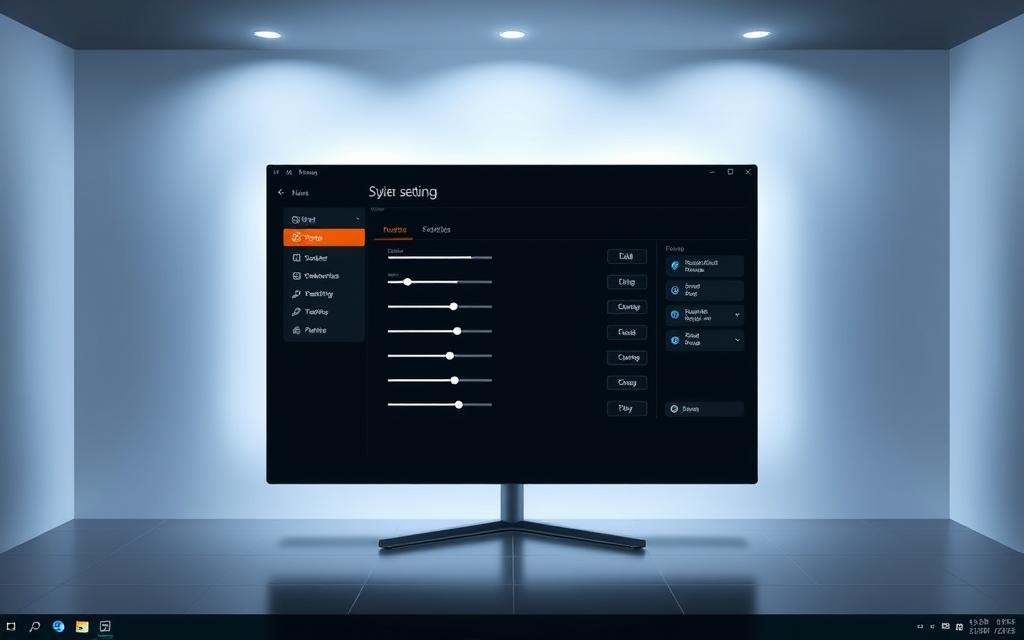
What is Game Mode?
Game Mode is a built-in feature in Windows 10 and 11. It reallocates CPU and GPU resources to your game, minimizing background interruptions. This ensures consistent frame rates and reduced lag during intense sessions.
How to Enable Game Mode in Windows 11 and Windows 10
Activating Game Mode is straightforward. Follow these steps:
- Press the Windows key + I to open settings.
- Navigate to the “Gaming” section.
- Toggle the “Game Mode” switch to On.
For advanced users, registry tweaks can further customize Game Mode. However, always create a system restore point before making changes.
“Game Mode ensures your system prioritizes gaming, delivering a smoother experience.”
If you encounter issues, verify activation through Task Manager. Look for reduced background processes while gaming. Performance may vary between laptop and desktop modes, so adjust accordingly.
| Device Type | Performance Impact |
|---|---|
| Laptop | Moderate improvement |
| Desktop | Significant boost |
Game Bar integration is another consideration. While useful for recording and streaming, it may slightly affect performance. Disable it if not needed for maximum efficiency.
Lower Your Resolution for Better Performance
Adjusting resolution settings can dramatically improve your system’s performance. Lowering the resolution reduces the workload on your GPU, resulting in higher frame rates and smoother gameplay. This is especially useful for older hardware or demanding titles.
How Resolution Affects FPS
Resolution directly impacts frame rates. Higher resolutions like 4K require more GPU power, often causing FPS drops. Lowering the resolution, such as switching to 1080p, can significantly boost performance. Tools like MSI Afterburner help monitor real-time FPS and GPU usage.
Aspect ratios also matter. A 16:9 ratio is standard, but ultrawide 21:9 monitors offer immersive experiences. However, wider resolutions demand more resources. Balancing resolution and aspect ratio ensures optimal performance.
Finding the Optimal Resolution for Your System
Finding the right resolution depends on your GPU’s VRAM capacity. For example, 4GB VRAM GPUs perform best at 1080p, while 8GB VRAM cards handle 1440p smoothly. In-game benchmarks, like Shadow of the Tomb Raider’s built-in test, help identify the best settings.
Render scale is another factor. Lowering it reduces internal rendering resolution while maintaining native display resolution. This is a great alternative for balancing visuals and performance. Technologies like DLSS (Nvidia) and FSR (AMD) also enhance performance without sacrificing quality.
Laptop displays often have limitations due to lower refresh rates. Connecting an external monitor with higher refresh rates can improve the experience. Experiment with different resolutions to find the sweet spot for your setup.
Update Your Graphics Card Drivers
Keeping your graphics drivers up-to-date ensures peak performance. Modern games and applications rely on optimized drivers for compatibility and stability. Outdated drivers can lead to crashes, stutters, and reduced frame rates.
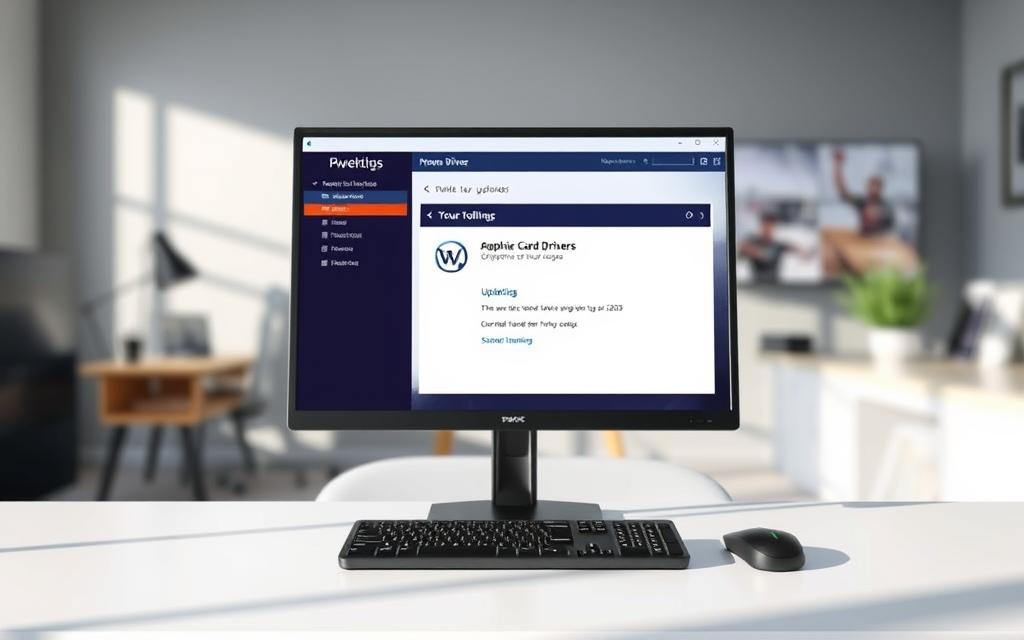
Why Updating Drivers is Crucial
Driver updates often include performance improvements and bug fixes. They ensure your system runs smoothly with the latest games and software. Nvidia’s GeForce Experience, for example, provides automatic updates tailored to your hardware.
AMD and Intel also release regular updates. These enhance compatibility with new titles and improve overall stability. Skipping updates can leave your GPU underperforming, even on high-end hardware.
How to Update Nvidia, AMD, and Intel Graphics Drivers
Updating drivers is straightforward. Here’s a breakdown for each manufacturer:
- Nvidia: Use GeForce Experience for automatic updates. Open the app, navigate to the “Drivers” tab, and click “Check for Updates.”
- AMD: Download the latest drivers from AMD’s website. Use the “Clean Install” option to remove old files and avoid conflicts.
- Intel: Visit Intel’s Driver & Support Assistant. It scans your system and recommends the latest drivers.
For manual updates, download the driver package from the manufacturer’s website. Follow the installation prompts carefully. Mobile GPUs, like Nvidia’s Max-Q designs, require specific drivers for laptops.
“Regular driver updates ensure your hardware performs at its best, especially in competitive gaming.”
If an update fails, try restarting your system or using the manufacturer’s troubleshooting tools. Driver rollback is also an option. Access it through Device Manager in Windows.
| Manufacturer | Update Method | Recommended Frequency |
|---|---|---|
| Nvidia | GeForce Experience | Monthly |
| AMD | Clean Install | Every 2 Months |
| Intel | Driver Assistant | Quarterly |
Competitive gamers should update drivers more frequently. New releases often include optimizations for popular titles. Staying current ensures you’re always ready for the next challenge.
Remove Unused Programs and Bloatware
Unused programs and bloatware can silently drain your computer’s resources. Over time, these unnecessary applications accumulate, slowing down your system and reducing efficiency. Removing them is a simple yet effective way to boost performance.
How Bloatware Affects Performance
Bloatware often runs in the background, consuming CPU and RAM. This can lead to slower load times and reduced responsiveness. Tools like AVG TuneUp’s Sleep Mode feature reduce background CPU usage by 37%, freeing up resources for essential tasks.
Tools to Remove Unnecessary Programs
Several utilities can help clean up your system. Revo Uninstaller and IObit Uninstaller are popular choices, offering advanced removal features. Windows’ native Program Manager has limitations, so third-party tools are often more effective.
- Use Revo Uninstaller for deep scans and leftover file removal.
- IObit Uninstaller excels at batch uninstalls and browser extension management.
- For manual cleanup, access the registry editor to delete residual entries.
Disk cleanup is another essential step. Temporary files and caches take up valuable space. Regularly clearing them ensures smoother operation. Browser extensions can also slow down your system. Remove unused or redundant ones to improve performance.
OEM-specific tools, like Dell SupportAssist, help identify and remove manufacturer-installed bloatware. However, be cautious when removing programs. Avoid deleting essential system components, as this can cause instability.
| Tool | Key Feature |
|---|---|
| Revo Uninstaller | Deep scan for leftover files |
| IObit Uninstaller | Batch uninstall and extension management |
| Dell SupportAssist | OEM-specific bloatware removal |
“Regularly cleaning up unused programs ensures your system runs at peak efficiency.”
Boost Your Wi-Fi for Reduced Lag
A stable internet connection is crucial for seamless gaming sessions. Lag spikes and high latency can disrupt gameplay, especially in competitive titles. Optimizing your Wi-Fi setup ensures smoother online experiences without costly upgrades.
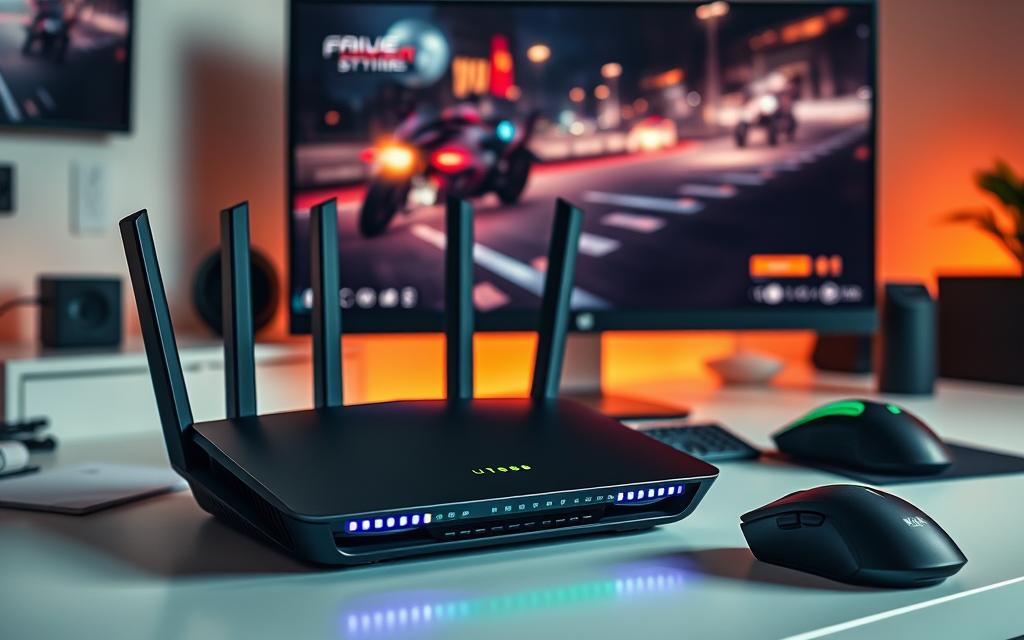
How a Slow Internet Connection Affects Gaming
Slow speeds cause delays in data transmission, leading to stutters and rubber-banding. In fast-paced games, even a slight delay can mean the difference between victory and defeat. A weak internet connection also affects multiplayer synchronization, making it harder to react in real-time.
Switching to a 5GHz network reduces latency by 40% compared to 2.4GHz in crowded areas. This simple change can significantly improve responsiveness. Tools like PingPlotter help identify network bottlenecks, allowing you to address them effectively.
Tips for Improving Wi-Fi Performance
Optimal router placement is key. Position your router centrally, away from walls and electronic devices that cause interference. Technologies like MU-MIMO and beamforming enhance signal strength and stability, especially in multi-device households.
Upgrading to Wi-Fi 6 offers faster speeds and lower latency. It’s ideal for modern gaming setups. For those unable to upgrade, Ethernet over Powerline adapters provide a wired-like experience without extensive cabling.
- Optimize DNS settings for faster domain resolution.
- Regularly update router firmware to ensure peak performance.
- Use a dedicated gaming VPN to reduce ping and avoid throttling.
“A well-optimized Wi-Fi setup ensures uninterrupted gaming, even in high-stakes matches.”
These adjustments maximize your network’s power, delivering a smoother and more reliable gaming experience. Whether you’re streaming or competing, these tips keep you ahead of the curve.
Adjust Your Monitor’s Refresh Rate
Optimizing your display settings can significantly enhance your gaming experience. A higher refresh rate ensures smoother visuals, reducing motion blur and screen tearing. This adjustment is especially beneficial for fast-paced games where every frame counts.

What is Refresh Rate and Why It Matters
The refresh rate refers to how many times your monitor updates the image per second. Measured in Hertz (Hz), a higher rate like 144Hz provides smoother motion compared to the standard 60Hz. This is crucial for competitive gaming, where responsiveness can determine success.
Modern displays support higher refresh rates, but they must be enabled in your system settings. Failing to do so means you’re not utilizing your hardware’s full potential. Adjusting this setting can transform your gaming experience.
How to Adjust Refresh Rate in Windows
Changing the refresh rate is straightforward. Follow these steps:
- Right-click on your desktop and select “Display settings.”
- Scroll down and click “Advanced display settings.”
- Under “Display adapter properties,” navigate to the “Monitor” tab.
- Select your desired refresh rate from the dropdown menu.
For advanced users, GPU control panels like Nvidia Control Panel or AMD Radeon Software offer additional options. These tools allow custom resolutions and refresh rates, providing greater flexibility.
| Refresh Rate | Best Use Case |
|---|---|
| 60Hz | Casual gaming and general use |
| 144Hz | Competitive gaming and fast-paced titles |
| 240Hz | Professional esports and high-end setups |
If your desired refresh rate isn’t listed, ensure your monitor and GPU support it. Tools like Custom Resolution Utility (CRU) can help unlock hidden rates. For multi-monitor setups, configure each display individually to avoid conflicts.
“A higher refresh rate reduces motion blur, making fast-paced games feel more responsive and immersive.”
Balancing refresh rate and color depth is also important. Higher rates may limit color accuracy, so choose based on your priorities. Experiment with different settings to find the optimal configuration for your system.
Configure Your Mouse and Controller Settings
Fine-tuning your input devices can significantly enhance precision and responsiveness during gameplay. Whether you’re using a mouse or controller, optimizing their settings ensures smoother and more accurate movements. This is especially important for competitive titles where every millisecond counts.
Why Mouse Acceleration Can Hurt Your Game
Mouse acceleration adjusts cursor speed based on how quickly you move the mouse. While it may seem helpful, it can disrupt muscle memory and consistency. Disabling it ensures your movements are predictable, improving aim and control.
How to Disable Mouse Acceleration
Disabling mouse acceleration is straightforward. Follow these steps:
- Open the Control Panel and navigate to “Mouse settings.”
- Go to the “Pointer Options” tab and uncheck “Enhance pointer precision.”
- Click “Apply” to save changes.
For persistent changes, edit the Windows registry. This ensures the setting remains disabled even after system updates. Advanced users can also use gaming mouse software like Logitech G Hub or Razer Synapse to override default options.
“Disabling mouse acceleration provides consistent cursor movement, essential for precise aiming in competitive games.”
Raw input settings in game engines bypass Windows’ mouse processing, offering even greater accuracy. Additionally, optimizing mouse polling rates and ensuring compatibility with your mouse pad surface further enhances performance. These tweaks work together to create a seamless and responsive gaming experience.
Disable Windows Game Bar
The Windows Game Bar, while useful for some, can hinder system performance during intense gaming sessions. This built-in feature, designed for quick access to recording and streaming options, often consumes valuable resources. Disabling it can free up CPU and GPU power, ensuring smoother gameplay.
How Windows Game Bar Affects Performance
The Game Bar runs in the background, even when not actively used. It can cause frame rate drops and stutters, especially in resource-intensive games. For competitive players, every millisecond counts, making this feature more of a hindrance than a help.
Tools like Task Manager reveal the Game Bar’s impact on CPU and RAM usage. Disabling it can lead to noticeable improvements in responsiveness and overall system efficiency.
Steps to Disable Windows Game Bar
Disabling the Game Bar is straightforward. Follow these steps:
- Open settings by pressing Windows key + I.
- Navigate to the “Gaming” section.
- Toggle the “Game Bar” switch to Off.
For advanced users, the Group Policy Editor offers a more permanent solution. This method is ideal for enterprise environments where consistent settings are required.
“Disabling the Game Bar ensures your system prioritizes gaming performance over unnecessary background processes.”
Registry edits provide another way to disable the Game Bar. However, always back up your registry before making changes. Terminating the Xbox Game Bar service via Task Manager can also stop it temporarily.
| System Type | Performance Impact |
|---|---|
| Low-End PCs | Significant improvement |
| High-End PCs | Moderate improvement |
If you encounter issues after disabling the Game Bar, perform a clean boot to diagnose conflicts. Alternative recording software, like OBS Studio, offers more control without impacting performance.
Upgrade Your Graphics Card
Enhancing your system’s visual and processing capabilities often starts with upgrading the graphics card. Modern games demand more from your hardware, and a powerful GPU ensures smoother gameplay and better visuals. Whether you’re aiming for 1440p or 4K resolution, the right card makes a significant difference.
When to Consider a Graphics Card Upgrade
Upgrading your GPU becomes necessary when your current card struggles with newer titles. If you’re experiencing low frame rates or stuttering in demanding games, it’s time for a change. Additionally, if you’re transitioning to a higher resolution monitor, like 1440p or 4K, a more powerful card is essential.
For 1440p gaming, an RTX 3060 Ti or RX 6700 XT is the minimum recommendation. These cards balance performance and cost, delivering a smooth experience without breaking the bank. Upgrading also benefits content creators, as modern GPUs accelerate rendering and editing tasks.
Choosing the Right Graphics Card for Your Needs
Selecting the right GPU depends on your specific requirements. Nvidia and AMD offer distinct feature sets, catering to different user needs. Nvidia excels in ray tracing and DLSS, while AMD provides better value with its RDNA architecture.
Consider your system’s form factor and power supply. High-end cards like the RTX 4080 require robust cooling and ample power. Ensure your case and PSU can accommodate the new hardware. Thermal design power (TDP) is another critical factor, as it impacts cooling requirements and energy consumption.
| Feature | Nvidia | AMD |
|---|---|---|
| Ray Tracing | Superior | Good |
| DLSS/FSR | DLSS 3.0 | FSR 2.0 |
| Value | Premium | Budget-Friendly |
“Choosing the right graphics card ensures your system is ready for both current and future gaming demands.”
The used market offers cost-effective options, but be cautious of cards previously used for cryptocurrency mining. These may have reduced lifespans due to prolonged stress. Always verify the card’s condition and warranty before purchasing.
Upgrade to an SSD for Faster Load Times
Switching to an SSD can transform your system’s performance dramatically. Unlike traditional HDDs, SSDs offer faster read/write speeds, reducing load times and improving overall responsiveness. This upgrade is particularly beneficial for gaming and multitasking, where speed is crucial.
Benefits of SSDs Over HDDs
SSDs outperform HDDs in several key areas. With no moving parts, SSDs are more durable and less prone to mechanical failure. They also consume less power, making them ideal for laptops and energy-efficient setups. The Crucial MX500 1TB, for example, offers read/write speeds of 560/510 MB/s, significantly faster than most HDDs.
Gamers benefit from reduced load times and smoother gameplay. Applications launch instantly, and file transfers are quicker. For content creators, SSDs accelerate rendering and editing tasks, saving valuable time.
How to Install an SSD in Your Gaming PC
Installing an SSD is straightforward, but requires careful planning. Here’s a step-by-step guide:
- Choose the Right SSD: Ensure compatibility with your motherboard. M.2 slots support both SATA and PCIe SSDs, with PCIe offering faster speeds.
- Backup Data: Decide between cloning your existing drive or performing a fresh install. Cloning preserves your data, while a fresh install ensures optimal performance.
- Install the SSD: Power down your computer and ground yourself to avoid static discharge. Insert the SSD into the appropriate slot and secure it with screws.
- Configure Settings: Access your BIOS to ensure the SSD is recognized. For M.2 SSDs, consider adding a heatsink to manage temperatures.
- Optimize Performance: For advanced users, RAID 0 configurations can further enhance speed by combining multiple SSDs.
| Feature | SSD | HDD |
|---|---|---|
| Read/Write Speed | 560/510 MB/s | 80/160 MB/s |
| Durability | High | Moderate |
| Power Consumption | Low | High |
“Upgrading to an SSD is one of the most effective ways to boost your hardware’s performance, offering faster load times and improved efficiency.”
By following these steps, you can maximize the benefits of your new SSD. Whether you’re gaming or working, this upgrade ensures your system runs at its best.
Increase Your RAM for Better Multitasking
Expanding your system’s memory capacity can significantly enhance multitasking and gaming performance. More RAM allows your computer to handle multiple applications and games with ease, reducing lag and improving responsiveness. Whether you’re streaming, editing, or gaming, upgrading your RAM ensures smoother operation.
How RAM Affects Gaming Performance
RAM plays a crucial role in gaming by storing temporary data for quick access. Insufficient memory can lead to stutters, longer load times, and reduced frame rates. For modern titles, 16GB is the minimum recommendation, while 32GB or more is ideal for multitasking and future-proofing your hardware.
CAS latency and frequency are key factors. Lower latency and higher frequency improve data transfer speeds, enhancing overall performance. For example, Crucial Pro DDR5-5600 offers 1.25x faster bandwidth than DDR4-3200, making it a solid choice for gamers.
Choosing the Right RAM for Your System
Selecting RAM involves considering your motherboard’s QVL (Qualified Vendor List) to ensure compatibility. Capacity recommendations vary by use case:
- 8GB: Basic gaming and everyday tasks.
- 16GB: Optimal for most gamers and multitaskers.
- 32GB+: Ideal for content creators and future-proof setups.
RGB vs non-RGB options are a matter of preference, but RGB modules often come with better cooling solutions. ECC (Error-Correcting Code) memory is essential for mission-critical systems, while non-ECC is sufficient for gaming.
Cooling considerations are important for high-performance RAM. Overclocking can increase power consumption and heat output, so ensure proper airflow in your case. Be cautious of counterfeit modules, which can compromise performance and reliability.
| Feature | DDR4 | DDR5 |
|---|---|---|
| Bandwidth | 3200 MB/s | 5600 MB/s |
| Power Efficiency | Moderate | High |
| Future-Proofing | Limited | Excellent |
“Upgrading your RAM is one of the most effective ways to boost your system’s multitasking and gaming capabilities.”
By selecting the right RAM and ensuring compatibility, you can maximize your hardware’s potential. Whether you’re gaming or working, this upgrade ensures your system runs at its best.
Conclusion: How to Make Your Gaming PC Better
Achieving peak performance in modern games requires a blend of hardware and software optimizations. Both paths offer unique benefits, with software tweaks providing immediate improvements and hardware upgrades delivering long-term gains.
Prioritize cost-effective upgrades like SSDs and additional RAM for noticeable boosts. Regular maintenance, including driver updates and system cleaning, ensures sustained performance. Monitoring tools help track progress and identify bottlenecks.
Upcoming technologies like DirectStorage promise even faster load times. For a detailed guide on optimizing your setup, check out this resource on how to optimize a PC for gaming.
Benchmarking your system before and after changes provides measurable results. Whether you’re a casual player or a competitive gamer, these strategies enhance your overall gaming experience.
FAQ
Does Game Mode actually improve performance?
Yes, Game Mode prioritizes system resources for games, which can boost frames per second and reduce lag. It minimizes background processes to enhance gaming performance.
How much does lowering resolution impact graphics quality?
Lowering resolution reduces visual sharpness but significantly increases FPS. For competitive gaming, many players prefer smoother performance over ultra-high resolution.
How often should I update my graphics card drivers?
Check for updates monthly or before playing new games. Nvidia GeForce, AMD Adrenalin, and Intel Graphics Command Center provide automatic notifications for driver updates.
Can bloatware really slow down my gaming PC?
Absolutely. Bloatware consumes CPU, RAM, and power, reducing available resources for games. Removing unnecessary programs improves overall system efficiency.
Does Wi-Fi speed affect single-player games?
Mostly no, but some single-player games still require online verification. For multiplayer titles, a stable connection is crucial to prevent lag and screen tearing.
What’s the ideal monitor refresh rate for gaming?
A 144Hz or higher refresh rate provides smoother visuals, especially in fast-paced games. Match this with a graphics card capable of high frame rates for the best experience.
Why disable mouse acceleration?
Mouse acceleration alters cursor speed based on mouse movement, reducing precision in games. Disabling it ensures consistent aim and better control.
Is Windows Game Bar worth keeping?
For performance-focused gamers, disabling Game Bar is better. However, if you use its recording or streaming features, weigh the trade-off between functionality and system resources.
When should I upgrade my graphics card?
Upgrade if your current card struggles with modern games at desired settings. Look for benchmarks comparing your GPU to newer models in titles you play.
How much faster is an SSD compared to an HDD?
SSDs load games 3-5 times faster than HDDs, reducing wait times. They also improve system responsiveness and decrease stuttering in open-world games.
How much RAM do I need for gaming?
16GB is ideal for most modern games. For multitasking or high-end titles, 32GB ensures smoother performance with background applications running.


